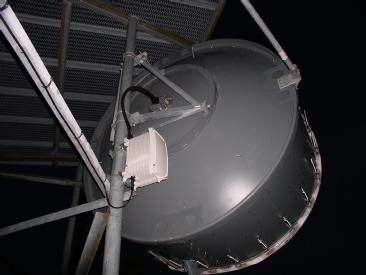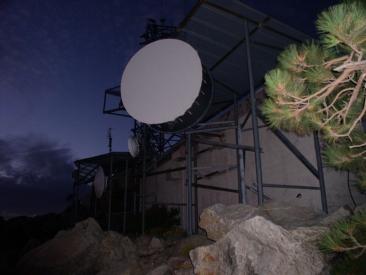|
September 4, 2008
HPWREN backbone upgrades to FCC-licensed radio spectrum completed
With the completion of the radio link upgrade between Mount
Laguna and Toro Peak on August 28, all main HPWREN backbone links
now utilize spectrum licensed by the Federal Communications Commission,
in either the 6 GHz or 11 GHz bands.
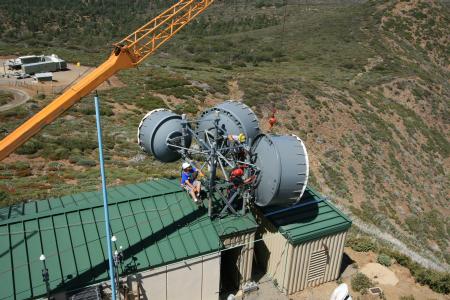 At Mount Laguna, utilizing a crane, the antennas to Toro Peak and
the SDSU Mount Laguna Observatory were replaced. Andrew Farrow, Ron
Serabia, and Mike Datte can be seen on the roof, with Jim Hale
directing the installation from the ground. Not seen in the above
photo is Bud Hale
(right photo), who ran a tag line to make sure the
antenna moved into its proper place, without damaging anything.
At Mount Laguna, utilizing a crane, the antennas to Toro Peak and
the SDSU Mount Laguna Observatory were replaced. Andrew Farrow, Ron
Serabia, and Mike Datte can be seen on the roof, with Jim Hale
directing the installation from the ground. Not seen in the above
photo is Bud Hale
(right photo), who ran a tag line to make sure the
antenna moved into its proper place, without damaging anything.
|
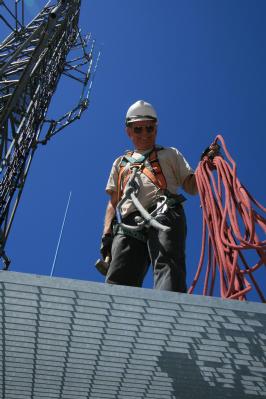
|
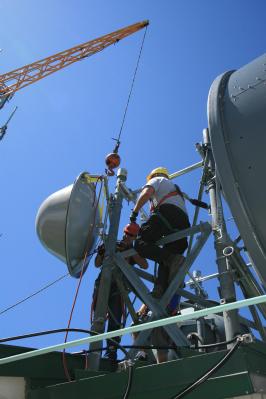
|
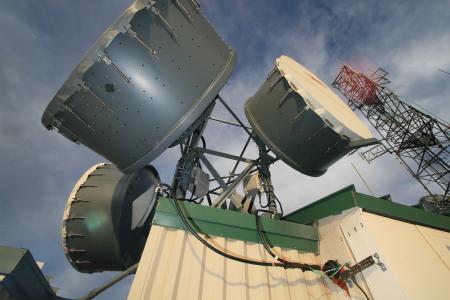
The last crane-based installation of the day was the antenna to
the Mount Laguna Observatory (left photo). Finally, a small
antenna to the California Wolf Center and a NASA satellite
tracking facility was re-installed on the left side of the above
photo between the two large eight-foot antennas.
|
|
These photos, taken by Glen Offield, show the nighttime completion
of the Toro Peak end of the link, at more than 8700 feet elevation.
With Glen Offield directing the rather involved installation in a
difficult to access location, Eduardo Perez, Matt Norenberg, Joel
White, Eric Blum, and Bruce Mrosko participated in making it all happen.
|
The High Performance Wireless Research and Education Network (HPWREN)
is a National Science Foundation funded network research project,
which also functions as a collaborative interdisciplinary and
multi-institutional cyberinfrastructure for research, education,
and first responder activities. Activities include the creation,
demonstration, and evaluation of a non-commercial, prototype, and
high-performance, wide-area wireless network in southern California.
This cyberinfrastructure project provides a technology environment
of strategic importance to its network usersa. Applications include
interdisciplinary science, engineering, and education as well as
public safety activities specifically beneficial to first responders.
General education, outreach and training opportunities are significant,
extending into distance-education oriented Live Interactive Virtual
Explorations (LIVE) activities.
In the west-east direction the network spans about 213 miles
from an island off the southern California coast via the inland
valleys, on to the high mountains (reaching more than 8700 feet),
and out to the remote desert, near the Arizona border. The network's
longest link is approximately 72 miles in distance, reaching from the San
Diego Supercomputer Center at UCSD to San Clemente Island. In the
north-south direction the network extends approximately 95
miles, reaching from the Joshua Tree National Park to about the
border with Mexico.
HPWREN originated in the year 2000, utilizing FCC license-exempt
2.4 GHz and 5.8 GHz radio spectra, primarily using 5.8 GHz full-duplex
45 megabit per second radios for the backbone, and slower 2.4 GHz
for access links. Notable exceptions include two astronomy observatories
and an ecological reserve, which were from the beginning connected
via 45 Mbps radios as well. The original backbone was established
in the 5.8 GHz spectrum due to an expectation of less interference
than the more commonly used 2.4 GHz band. The goal was to protect
the backbone network over its access links, since if the backbone
fails, access links would not be of much value anyway.
The Federal Communications Commission has been an enabler to
making this project possible, initially by the public availability
of license-exempt 2.4 GHz and 5.8 GHz radio spectrum, but also by
providing FCC licenses in the 6 GHz and 11 GHz band that are
straightforward to obtain. Consistently professional FCC staff have
played key roles in the success of HPWREN and its derivatives.
The following graphics provide some snapshots of the evolution of
the HPWREN topology.
|
In October 2000, the Pala National American Reservation Learning
Center became the first operational remote site on the network.
By December of that year, the HPWREN backbone extended from UCSD
at the coast across about 50 miles to Mount Laguna, and also
connected the SDSU Mount Laguna Observatory.
|
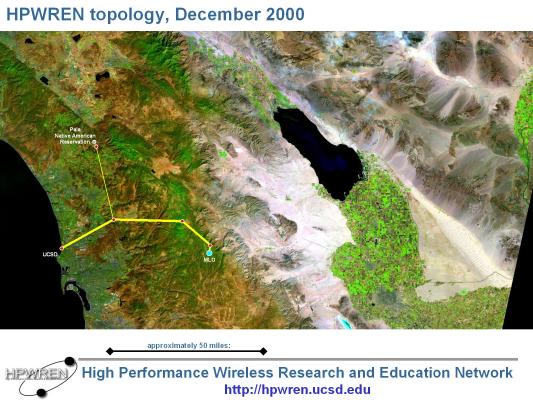
|
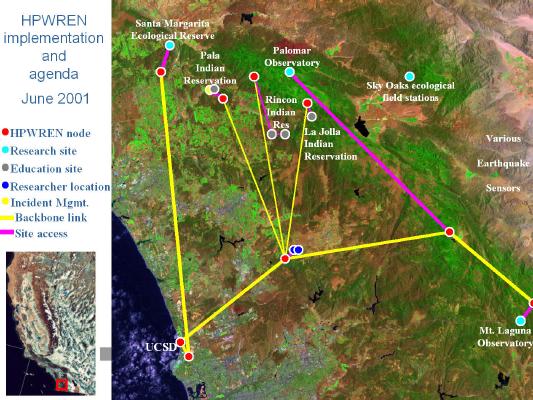
|
In June 2001, the La Jolla (January) and Rincon (March) Native
American Reservations connected to HPWREN. Caltech's Palomar
Observatory was added in August, and SDSU's Santa Margarita Ecological
Reserve was added by October. Later in the year, a transition of
the Native American links to their new Tribal Digital Village Network
project began, alongside substantial technology and expertise transfer.
|
|
In 2002, TDVnet extended the connectivity to many more Native
American reservations, while still relying on HPWREN for Internet
connectivity. By September 2002, HPWREN's original 5.8 GHz link to Toro
Peak was established. This allowed for real-time seismic sensor
telemetry to flow via HPWREN, and enabled network connectivity for
many other projects surrounding Toro Peak.
|
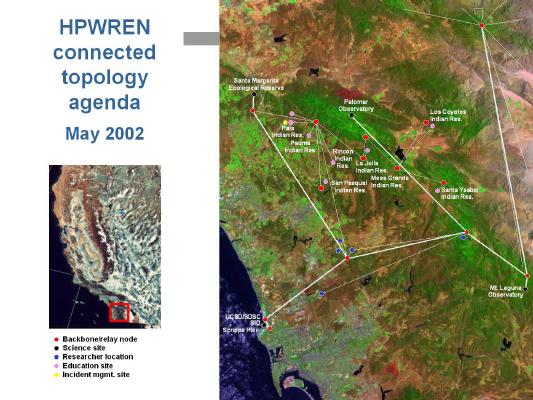
|
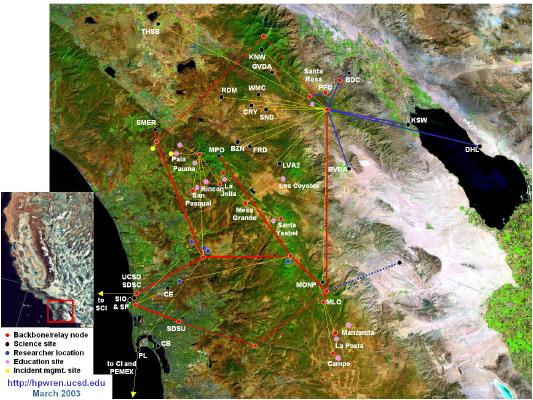
|
By March 2003, work was under way to substantially improve the
backbone's robustness by creating a redundant topology. This also included
connecting San Diego State University as a network backbone site.
The dashed/planned links on top of the graphic were never finished, as
over years, it turned out to be too difficult to obtain deployment
facilities and agreements.
|
|
May 2003 saw the first transition to an FCC-licensed 6 GHz backbone
link. This was another step to increase network robustness, with
the licensed-spectrum upgrade targeted toward an elimination of radio
interference.
|
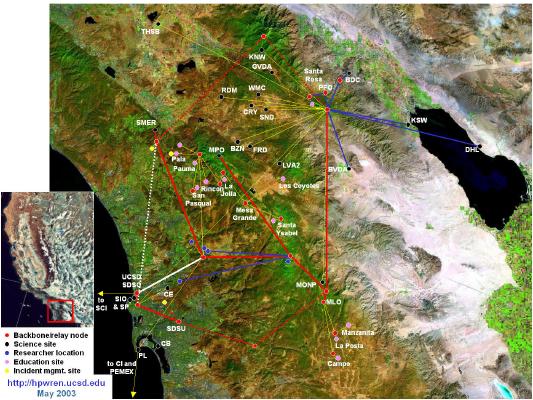
|
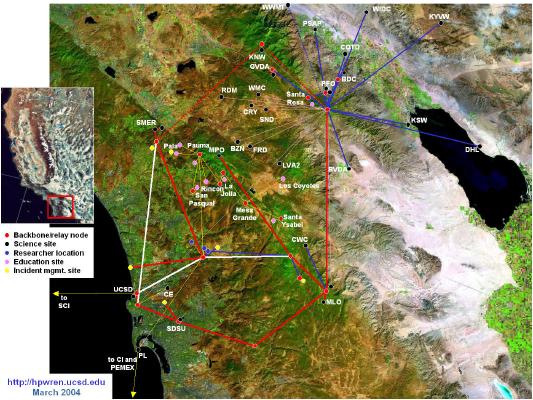
|
By March 2004, two more licensed links were added, one to extend
the reach of licensed links further east, the other to replace a very
difficult link, fade-wise, to reach the Santa Margarita Ecological Reserve.
The link supporting SMER utilizes HPWREN's largest antennas, which are
10 feet in diameter. In addition, the main part of the HPWREN backbone
topology by now was facilitated by redundant links.
|
|
By July 2004, significant work was under way to extend HPWREN more
eastward, mostly driven by SIO and UCSB requirements.
|
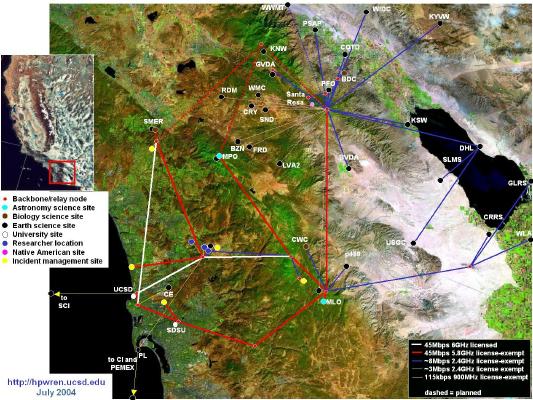
|
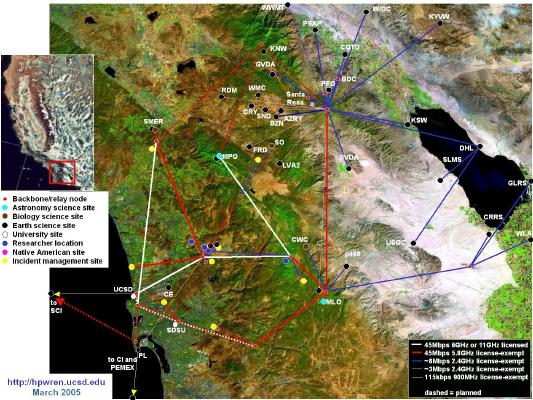
|
In March of 2005, the Caltech Palomar Observatory connection was upgraded
to an FCC-licensed link, with Caltech participating in the cost by
funding the new equipment. By now the Palomar Observatory's
connection is licensed all the way to the Internet interconnect at the
coast, which is provided by the San Diego Supercomputer Center.
|
|
In August 2005, part of the southern backbone
was licensed, using 11 GHz radios.
|
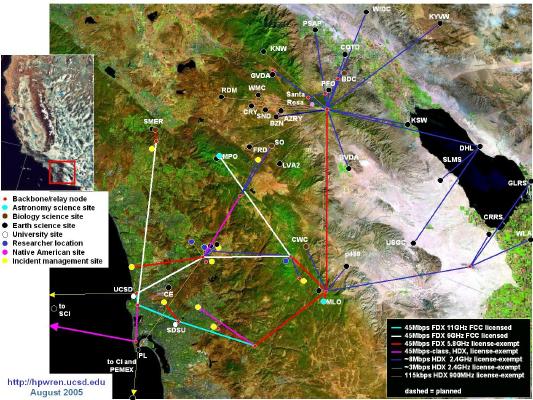
|
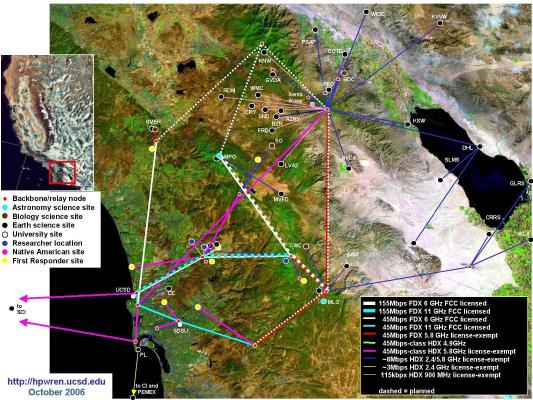
|
By October 2006, plans were under way to transition the rest of the
backbone to FCC-licensed links, and to upgrade some critical paths to
155 megabits per second, with a specific focus on providing
substantially higher bandwidth to the Palomar Observatory.
|
|
By September 2007, HPWREN's FCC-licensed connectivity reached all
the way to Mount Laguna.
|
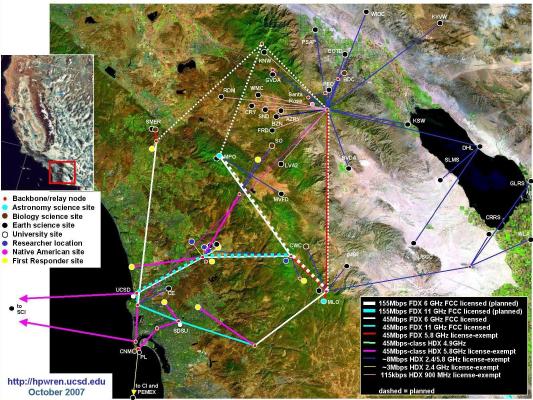
|
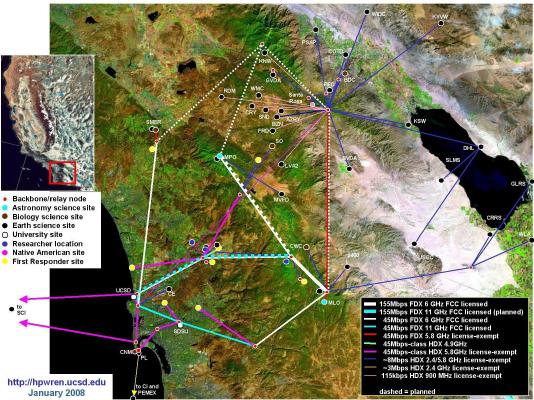
|
By January 2008, the entire main network loop was FCC-licensed, and
HPWREN's first operational 155 Mbps link was installed and
operational.
|
|
Based on further link upgrades, the entire path to the Palomar
Observatory was transitioned to 155Mbps by March 2008, with
the Observatory again having funded the new equipment for the last
hop. Around this time, the plan for the redundant northern links
had been abandoned, in favor or a new plan for a site much further
in the west. The new links will utilize equipment freed up during
the previous 155Mbps upgrades, and provide the Palomar Observatory with
redundant connectivity and an aggregated bandwidth of about 200Mbps.
|
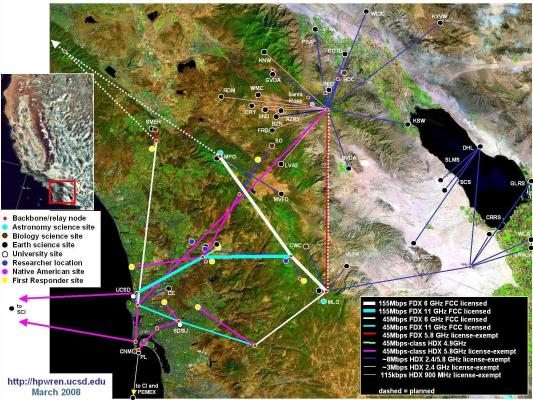
|
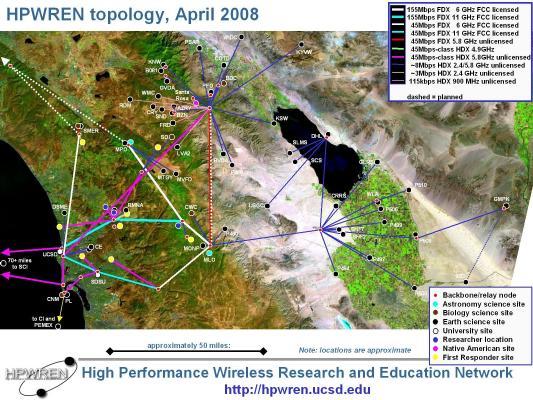
|
The network now extends in the east near Arizona, with the
additions and upgraded east of Mount Laguna done by the Scripps
Institution of Oceanography.
|
|
By August 2008, the entire main backbone network has been
transitioned to 6 GHz and 11 GHz FCC-licensed spectra, while using a
combination of 45 Mbps and 155Mbps full-duplex radio links.
|
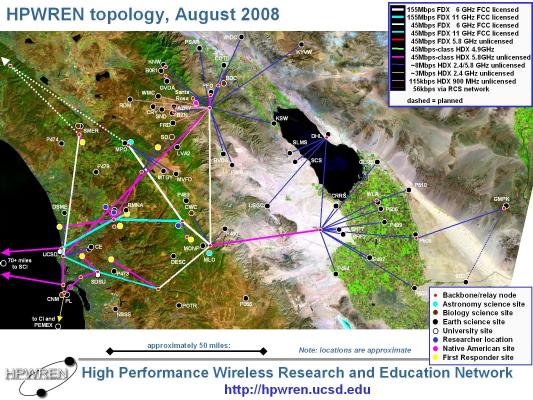
|
For additional information, prior to this HPWREN update, and
since its beginning in 2000, there were 184 articles posted at /news/,
specifically 5 in 2000, 21 in 2001, 21 in 2002, 22 in 2003, 18 in
2004, 26 in 2005, 26 in 2006, 27 in 2007, and 18 so far in 2008. A
2006 HPWREN summary brochure can be found at
/HPWREN_Brochure_2006/hpwren-brochure-2006.pdf.
|





